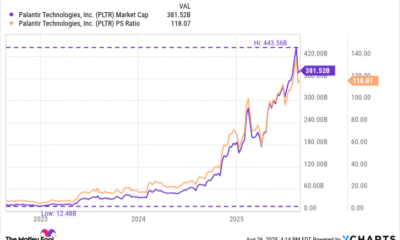AI Research
SoundHound AI, or This Other Magnificent Artificial Intelligence Stock?

-
SoundHound AI is a rapidly growing specialist in conversational artificial intelligence (AI), and it amassed an impressive list of customers.
-
DigitalOcean provides cloud services to small and mid-sized businesses, and now it’s helping those customers tap into the AI revolution.
-
There are positives and negatives for both, but one clearly looks like the better investment right now.
SoundHound AI (NASDAQ: SOUN) is a leading developer of conversational artificial intelligence (AI) software, and its revenue is growing at a lightning-fast pace. Its stock soared by 835% in 2024 after Nvidia revealed a small stake in the company, although the chip giant has since sold its entire position.
DigitalOcean (NYSE: DOCN) is another up-and-coming AI company. It operates a cloud computing platform designed specifically for small and mid-sized businesses (SMBs), which features a growing portfolio of AI services, including data center infrastructure and a new tool that allows them to build custom AI agents.
With the second half of 2025 officially underway, which stock is the better buy between SoundHound AI and DigitalOcean?
SoundHound AI amassed an impressive customer list that includes automotive giants like Hyundai and Kia and quick-service restaurant chains like Chipotle and Papa John’s. All of them use SoundHound’s conversational AI software to deliver new and unique experiences for their customers.
Automotive manufacturers are integrating SoundHound’s Chat AI product into their new vehicles, where it can teach drivers how to use different features or answer questions about gas mileage and even the weather. Manufacturers can customize Chat AI’s personality to suit their brand, which differentiates the user experience from the competition.
Restaurant chains use SoundHound’s software to autonomously take customer orders in-store, over the phone, and in the drive-thru. They also use the company’s voice-activated virtual assistant tool called Employee Assist, which workers can consult whenever they need instructions for preparing a menu item or help understanding store policies.
SoundHound generated $84.7 million in revenue during 2024, which was an 85% increase from the previous year. However, management’s latest guidance suggests the company could deliver $167 million in revenue during 2025, which would represent accelerated growth of 97%. SoundHound also has an order backlog worth over $1.2 billion, which it expects to convert into revenue over the next six years, so that will support further growth.
AI Research
How AI Upended a Historic Antitrust Case Against Google

When the United States Justice Department first sued to break up Google alleging that it illegally monopolized online search in October 2020, there was little indication that one of the biggest factors in the case would be the rapid rise of a nascent technology.
On Tuesday, US District Court Judge Amit P. Mehta ordered Google to stop using exclusive agreements with third-parties to distribute its search engine, but stopped short of forcing the company to cease such payments altogether or to spin off its Chrome web browser.
The decision over legal remedies in the case deals a significant blow to US antitrust enforcers after securing a historic ruling declaring that Google maintained an illegal monopoly last year.
Notably, Mehta’s 226-page liability decision heavily emphasized the role that the ascendance of artificial intelligence, particularly generative AI (or “GenAI”) products like OpenAI’s ChatGPT, played in his assessment of the case.
“The emergence of GenAI changed the course of this case,” Mehta wrote in his 226-page ruling.
Tech Policy Press reviewed Mehta’s mentions of AI tools and companies and his characterization of Google’s position in this emerging market to see how his assessment of the technology impacted his deliberations. Here’s what we found:
A blip during liability discussion, a major talking point over remedies
Google’s competitive position in the booming yet still emerging AI market featured prominently in Mehta’s decision Tuesday, a contrast with his earlier ruling finding that Google monopolized online search. As CNBC reported, “OpenAI’s name comes up 30 times, Anthropic is named six times and Perplexity shows up in 24 instances. …ChatGPT was named 28 times in Tuesday’s filing.” Aside from OpenAI, the companies had not yet been founded when the case was filed.
Additionally, “AI” and “artificial intelligence” were mentioned 116 times combined, generative “artificial intelligence,” “generative AI” and “GenAI” were referenced 220 times, and “large language models” and “LLM” were mentioned 82 times, according to our review.
By contrast, Mehta barely made reference to AI’s rise in his decision declaring Google a monopoly last year. In that 286-page decision, Mehta mentioned ChatGPT only twice, and OpenAI, Perplexity and Anthropic not at all. “Generative artificial intelligence” was mentioned seven times, while “generative AI” and “GenAI” were not referenced at all, and “large language model” and “LLM” were referenced only a dozen times.
Mehta himself alluded to this discrepancy, noting that the tools played a far bigger role in the latter remedies phase of the trial than the earlier liability phase. While no AI competitors have yet to make gains on Google, Mehta wrote, the tools “may yet prove to be game changers.”
No witness at the liability trial testified that GenAI products posed a near-term threat to GSEs [general search engines]. The very first witness at the remedies hearing, by contrast, placed GenAI front and center as a nascent competitive threat. These remedies proceedings thus have been as much about promoting competition among GSEs as ensuring that Google’s dominance in search does not carry over into the GenAI space.
Projecting AI’s path in search
Mehta lamented that the case required the court to “gaze into a crystal ball and look to the future,” which he said was not “exactly a judge’s forte.” But he sought to do just that and paint a picture of how AI tools are now and could soon intersect with Google’s grip over search.
Mehta wrote that “tens of millions of people use GenAI chatbots, like ChatGPT, Perplexity, and Claude, to gather information that they previously sought through internet search,” and that experts expect generative AI tools to increasingly perform like search engines.
“Like a GSE, consumers can interact with AI chatbots by entering information seeking queries. … Thus, chatbots perform an information-retrieval function like that performed by GSEs,” he wrote, though he noted chatbots can also perform distinct functions, like generating images.
Their aim, he wrote, is to “transform chatbots into a kind of “[s]uper [a]ssistant” able to perform “‘any task’” asked by a user. “Search is a necessary component of this product vision,” he concluded.
Mehta also considered current evidence that the tools are already factoring into the online search landscape. While he noted that Google may now be using its own AI tools to strengthen its dominance over search, a key concern for US authorities, he also wrote that “GenAI products may be having some impact on GSE usage,” and that competitors are also looking to use AI tools to onboard users onto their products as “access points” for search queries. Mehta alludes to the vision shared by AI firms that one such access point may eventually be a “super assistant” that “would be able to help perform ‘any task’ requested by the user.”
A “highly competitive” AI market
In his discussion of the current generative AI market, Mehta described it as “highly competitive” with “numerous new market entrants” in recent years, including the Chinese firm DeepSeek and Elon Musk’s Grok, and wrote that Google is not exactly in pole position to dominate it.
“There is constant jockeying for a lead in quality among GenAI products and models … Today, Google’s models do not have a distinct advantage over others in factuality or other technical benchmarks.”
He listed Anthropic, Meta, Microsoft, OpenAI, Perplexity, xAI, and DuckDuckGo as other participants in the market, and noted that they “have access to a lot of capital” to compete.
Mehta also wrote that generative AI companies have “had some success” in striking their own distribution agreements with device manufacturers to place their products, including partnerships between OpenAI and Microsoft and Perplexity with Motorola.
This section echoed many of the points Google made in its defense. Last year, the company wrote in a blog post about the case that the court was evaluating a “highly dynamic” market. “Since the trial ended over a year ago, AI has already rapidly reshaped the industry, with new entrants and new ways of finding information, making it even more competitive,” Google wrote.
The company has said it plans to appeal the initial liability ruling finding that it maintained an illegal monopoly, while in a statement released following the decision DOJ leaders appeared to suggest they may appeal the remedies Mehta doled out this week.
Some solace for US enforcers
While Mehta’s decision was far less sweeping than US antitrust enforcers had hoped for, his remedies will impact Google’s relationship with its budding AI rivals.
Mehta ordered Google to cease exclusive distribution agreements and share some of the data it uses to power its search business, including with companies in the AI space.
Because their functionality only partially overlaps, GenAI chatbots have not eliminated the need for GSEs. … Nevertheless, the capacity “to fulfill a broad array of informational needs” constitutes a defining feature of both products, as Google implicitly acknowledges. … And it is that capacity that renders GenAI a potential threat to Google’s dominance in the market for general search services.
But Google’s seeming inability to significantly leverage its dominance in search to quickly boost its AI offerings appeared to be a major sticking point for Mehta in weighing tougher sanctions.
The evidence did not show, for instance, that Google’s GenAI product responses are superior to other GenAI offerings due to Google’s access to more user-interaction data. If anything, the evidence established otherwise: The GenAI product space is highly competitive, and Google’s Gemini app, for instance, does not have a distinct advantage over chatbots in factuality and other technical benchmarks.
Mehta did leave the door open that if the situation changes, the court could intervene more substantially. Market “realities give the court hope that Google will not simply outbid competitors for distribution if superior products emerge,” Mehta wrote. “The court is thus prepared to revisit a payment ban (or a lesser remedy) if competition is not substantially restored through the remedies the court does impose.” Presumably that determination would be informed by the work of the Technical Committee established by the court, which is set to function throughout the six-year term of the judgment.
AI Research
NSF announces up to $35 million to stand up AI research resource operations center

The National Science Foundation plans to award up to $35 million to establish an operations center for its National AI Research Resource, signaling a step toward the pilot becoming a more permanent program.
Despite bipartisan support for the NAIRR, Congress has yet to authorize a full-scale version of the resource designed to democratize access to tools needed for AI research. The newly announced solicitation indicates the project is taking steps to scale the project absent additional support.
“The NAIRR Operating Center solicitation marks a key step in the transition from the NAIRR Pilot to building a sustainable and scalable NAIRR program,” Katie Antypas, who leads NSF’s Office of Advanced Cyberinfrastructure, said in a statement included in the announcement.
She added that NSF looks forward to collaborating with partners in the private sector and other agencies, “whose contributions have been critical in demonstrating the innovation and scientific impact that comes when critical AI resources are made accessible to research and education communities across the country.”
The NAIRR began as a pilot in January 2024 as a resource for researchers to access computational data, AI models, software, and other tools that are needed for AI research. Since then, the public-private partnership pilot has supported over 490 projects in 49 states and Washington, per its website, and is supported by contributions from 14 federal agencies and 28 private sector partners.
As the pilot has moved forward, lawmakers have attempted to advance bipartisan legislation that would codify the NAIRR, but those bills have not passed. Previous statements from science and tech officials during the Biden administration made the case that formalization would be important as establishing NAIRR fully was expected to take a significant amount of funding.
In response to a FedScoop question about funding for the center, an NSF spokesperson said it’s covered by the agency’s normal appropriations.
NAIRR has remained a priority even as the Trump administration has sought to make changes to NSF awards, canceling hundreds of grants that were related to things like diversity, equity and inclusion (DEI) and environmental justice. President Donald Trump’s AI Action Plan, for example, included a recommendation for the NAIRR to “build the foundations for a lean and sustainable NAIRR operations capability.”
According to the solicitation, NSF will make an award of a maximum of $35 million for a period of up to five years for the operations center project. That award will be made to a single organization. That awardee would ultimately be responsible for establishing a “community-based organization,” including tasks such as establishing the operation framework, working with stakeholders, and coordinating with the current pilot project functions.
The awardee would also be eligible to expand their responsibilities and duties at a later date, depending on factors such as NAIRR’s priorities, the awardee’s performance and funding.
AI Research
Top AI Code Generation Tools of 2025 Revealed in Info-Tech Research Group’s Emotional Footprint Report
The recently published 2025 AI Code Generation Emotional Footprint report from Info-Tech Research Group highlights the top AI code generation solutions that help organizations streamline development and support innovation. The report’s insights are based on feedback from users on the global IT research and advisory firm’s SoftwareReviews platform.
TORONTO, Sept. 3, 2025 /PRNewswire/ – Info-Tech Research Group has published its 2025 AI Code Generation Emotional Footprint report, identifying the top-performing solutions in the market. Based on data from SoftwareReviews, a division of the global IT research and advisory firm, the newly published report highlights the five champions in AI-powered code generation tools.
AI code generation tools make coding easier by taking care of repetitive tasks. Instead of starting from scratch, developers get ready-made snippets, smoother workflows, and support built right into their IDEs and version control systems. With machine learning and natural language processing behind them, these tools reduce mistakes, speed up projects, and give developers more room to focus on creative problem solving and innovation.
Info-Tech’s Emotional Footprint measures high-level user sentiment. It aggregates emotional response ratings across 25 proactive questions, creating a powerful indicator of overall user feeling toward the vendor and product. The result is the Net Emotional Footprint, or NEF, a composite score that reflects the overall emotional tone of user feedback.
Data from 1,084 end-user reviews on Info-Tech’s SoftwareReviews platform was used to identify the top AI code generation tools for the 2025 Emotional Footprint report. The insights support organizations looking to streamline development, improve code quality, and scale their software delivery capabilities to drive innovation and business growth.
The 2025 AI Code Generation Tools – Champions are as follows:
- Visual Studio IntelliCode, +96 NEF, ranked high for delivering more than promised.
- ChatGPT 5, +94 NEF, ranked high for its effectiveness.
- GitHub Copilot, +94 NEF, ranked high for its transparency.
- Replit AI, +96 NEF, ranked high for its reliability.
- Amazon Q Developer, +94 NEF, ranked high for helping save time.
Analyst Insight:
“Organizations that adopt AI code generation tools gain a significant advantage in software delivery and innovation,” says Thomas Randall, a research director at Info-Tech Research Group. “These tools help developers focus on complex, high-value work, improve code quality, and reduce errors. Teams that delay adoption risk slower projects, lower-quality software, and missed opportunities to innovate and stay competitive.”
User assessments of software categories on SoftwareReviews provide an accurate and detailed view of the constantly changing market. Info-Tech’s reports are informed by the data from users and IT professionals who have intimate experience with the software throughout the procurement, implementation, and maintenance processes.
Read the full report: Best AI Code Generation Tools 2025
For more information about Info-Tech’s SoftwareReviews, the Data Quadrant, or the Emotional Footprint, or to access resources to support the software selection process, visit softwarereviews.com.
About Info-Tech Research Group
Info-Tech Research Group is one of the world’s leading research and advisory firms, proudly serving over 30,000 IT and HR professionals. The company produces unbiased, highly relevant research and provides advisory services to help leaders make strategic, timely, and well-informed decisions. For nearly 30 years, Info-Tech has partnered closely with teams to provide them with everything they need, from actionable tools to analyst guidance, ensuring they deliver measurable results for their organizations.
To learn more about Info-Tech’s divisions, visit McLean & Company for HR research and advisory services and SoftwareReviews for software buying insights.
Media professionals can register for unrestricted access to research across IT, HR, and software, and hundreds of industry analysts through the firm’s Media Insiders program. To gain access, contact [email protected].
For information about Info-Tech Research Group or to access the latest research, visit infotech.com and connect via LinkedIn and X.
About SoftwareReviews
SoftwareReviews is a division of Info-Tech Research Group, a world-class technology research and advisory firm. SoftwareReviews empowers organizations with the best data, insights, and advice to improve the software buying and selling experience.
For buyers, SoftwareReviews’ proven software selection methodologies, customer insights, and technology advisors help maximize success with technology decisions. For providers, the firm helps build more effective marketing, product, and sales processes with expert analysts, how-to research, customer-centric marketing content, and comprehensive analysis of the buyer landscape.
SOURCE Info-Tech Research Group

-

 Business5 days ago
Business5 days agoThe Guardian view on Trump and the Fed: independence is no substitute for accountability | Editorial
-
Tools & Platforms3 weeks ago
Building Trust in Military AI Starts with Opening the Black Box – War on the Rocks
-

 Ethics & Policy1 month ago
Ethics & Policy1 month agoSDAIA Supports Saudi Arabia’s Leadership in Shaping Global AI Ethics, Policy, and Research – وكالة الأنباء السعودية
-

 Events & Conferences4 months ago
Events & Conferences4 months agoJourney to 1000 models: Scaling Instagram’s recommendation system
-

 Jobs & Careers2 months ago
Jobs & Careers2 months agoMumbai-based Perplexity Alternative Has 60k+ Users Without Funding
-

 Education2 months ago
Education2 months agoVEX Robotics launches AI-powered classroom robotics system
-

 Funding & Business2 months ago
Funding & Business2 months agoKayak and Expedia race to build AI travel agents that turn social posts into itineraries
-

 Podcasts & Talks2 months ago
Podcasts & Talks2 months agoHappy 4th of July! 🎆 Made with Veo 3 in Gemini
-

 Podcasts & Talks2 months ago
Podcasts & Talks2 months agoOpenAI 🤝 @teamganassi
-

 Education2 months ago
Education2 months agoAERDF highlights the latest PreK-12 discoveries and inventions





















